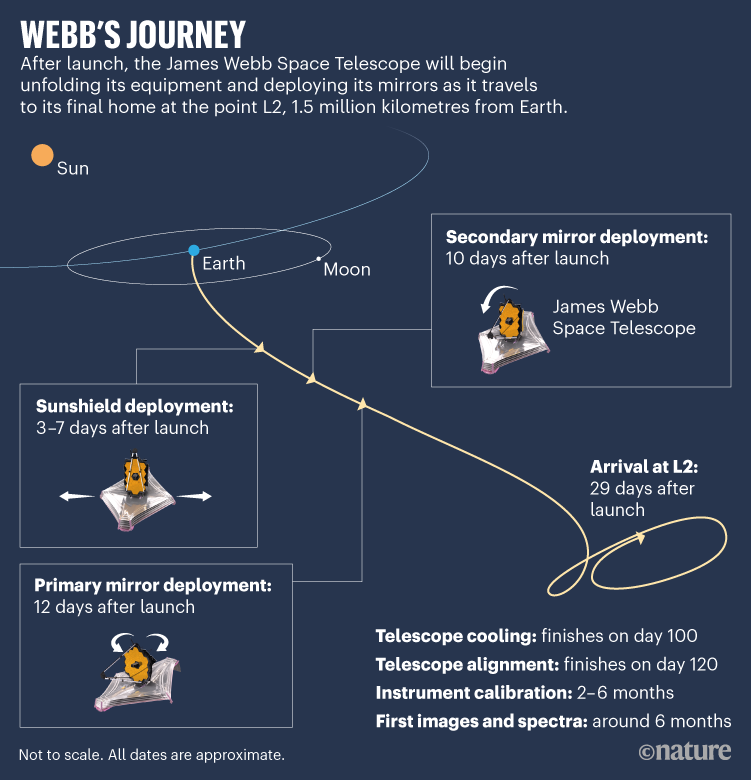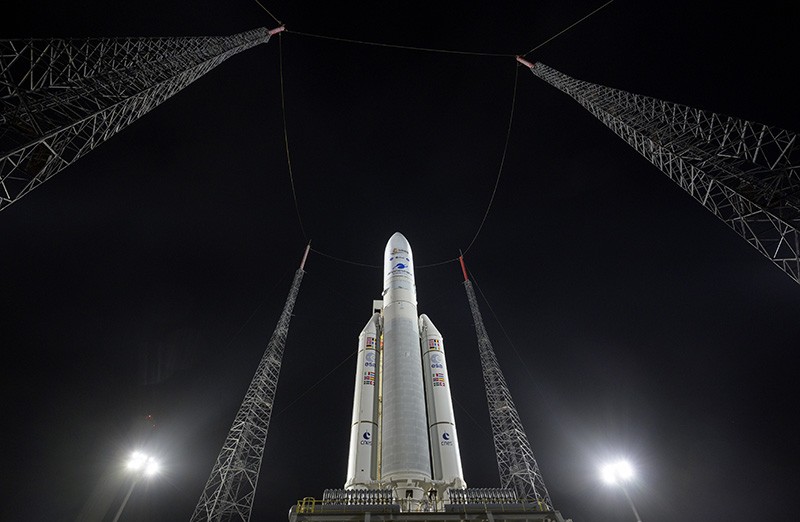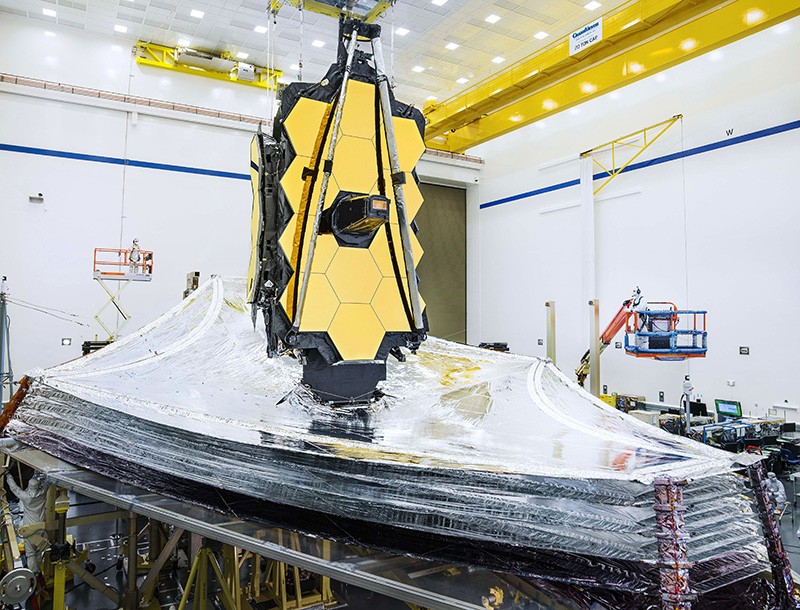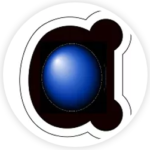Webb telescope blasts off successfully — launching a new era in astronomy
The James Webb Space Telescope — humanity’s biggest gamble yet in its quest to probe the Universe — soared into space on 25 December, marking the culmination of decades of work by astronomers around the world. But for Webb to begin a new era in astronomy, as many scientists hope it will, hundreds of complex engineering steps will have to go off without a hitch in the coming days and weeks.
Try Adsterra Earnings, it’s 100% Authentic to make money more and more.

“Now the hard part starts,” says John Grunsfeld, an astrophysicist and former astronaut and head of science for NASA.
The US$10-billion Webb is the most complicated and expensive space observatory in history, and the successor to NASA’s Hubble Space Telescope, which has studied the Universe since 1990. Following its launch, Webb will now embark on the riskiest part of its mission — deploying all the parts required for its enormous mirror to peer deep into the cosmos, back towards the dawn of time.
Not until all the equipment works and the first scientific observations have been made, probably in July, will astronomers be able to relax. Until then, “there’s going to be a lot of nervousness”, says Heidi Hammel, an interdisciplinary scientist for Webb and vice-president for science at the Association of Universities for Research in Astronomy in Washington DC.
The NASA-built Webb launched at 9.20 a.m. local time from the Kourou spaceport in French Guiana, on an Ariane 5 rocket provided by the European Space Agency (ESA). The project’s third international partner is the Canadian Space Agency.
“What an emotional day,” said Thomas Zurbuchen, NASA’s head of science, on a webcast from the launch site. “It’s the beginning of one of the most amazing missions that humanity has conceived.”
“I’m feeling very emotional right now after seeing something we’ve all waited for for so long finally happen,” adds Jeyhan Kartaltepe, an astronomer at the Rochester Institute of Technology in New York who has been awarded observing time on Webb. “I am super grateful for everyone that worked so hard to make it a success.”


Telescope images: NASA
Setting a course
The Ariane 5 carried Webb on an apparently flawless trajectory into space, which conserves more fuel for the telescope to use for science in the coming years. After separating from the launch vehicle 27 minutes after launch, Webb unfolded its solar panels, a crucial step that allowed electrical power to begin flowing. “That was half an hour on the edge of my seat,” says Grunsfeld. Hours later, it was expected to burn its engines to set it on course toward its ultimate destination, a position in space known as the second Lagrange point, or L2 (see ‘Webb’s journey’). There, 1.5 million kilometres from Earth, it will always be on the opposite side of the planet from the Sun, looking into the dark reaches of outer space with its sensitive optics shielded from sunlight.
The journey to L2 will take 29 days, with more than 300 ‘points of failure’ at which something could go wrong. The entire process is something like a butterfly emerging from its chrysalis, says Günther Hasinger, ESA’s director of science — a very expensive and very complex butterfly that is three storeys tall.
First and most crucial is the deployment of Webb’s kite-shaped sunshield, which is the size of a tennis court. The shield’s job is to shade Webb from radiation, and cool the environment from 110 ºC on the Sun-facing side to –235 ºC on the shaded side. Webb requires frigid temperatures for its optics to be able to pick up the glimmers of distant galaxies and other cosmic objects in infrared wavelengths.


The telescope launched on a European Ariane 5 rocket.Credit: Bill Ingalls/NASA
“The unique aspect about Webb is that it is a cold telescope,” says Hasinger. If the sunshield does not deploy properly, Webb’s science will be severely degraded.
Three days after launch, two rectangular pallets are meant to unfold on either side of the observatory. Over the course of four more days, the pallets will open to reveal the five membrane-like layers of the sunshield, and then stretch them and fix them in place, like tightening a sheet over a mattress.
Mirror alignment
Ten days after launch, if all goes well, Webb will move its small secondary mirror to face its giant primary mirror, which will still be folded up. Two days later, the primary mirror will begin to swing two hinged sections into place to create the complete 6.5-metre-wide mirror. At that point, the mirror’s 18 hexagonal segments, made of beryllium and coated in gold, will resemble a gigantic glimmering honeycomb — and Webb will become a true telescope, Hammel says, because it will be able to capture light.
Roughly two weeks later, Webb should reach its final location at L2. That is too far from Earth for astronauts to visit and fix the telescope if anything goes wrong, as they did after Hubble launched with flawed optics. (Astronauts, including Grunsfeld, ultimately flew to Hubble five times to upgrade its scientific instruments and keep it as a world-class observatory.) But if the sunshield and the mirrors deploy properly, then the worst is behind Webb. From then on, it’s a matter of aligning the mirrors and calibrating the instruments. Those steps are complicated but have been done before, on ground-based telescope mirrors.
One reason it will be six months before science can begin is that the telescope needs time to cool down to its operating temperature. Only about four months after launch will the primary mirror segments be sufficiently cooled and aligned to assume the correct shape. Mission engineers will then begin calibrating the instruments.
And one of the telescope’s four instruments, which will work in mid-infrared wavelengths, requires another cooler to get to –266 ºC, just 7 ºC above absolute zero. Once it reaches that temperature, Webb should be 100 times more sensitive than Hubble.


The telescope’s beryllium and gold mirror sits in the middle of a five-layered sunshield.Credit: Chris Gunn/NASA
Infrared eyes
Webb’s infrared vision will allow it to peer back more than 13.5 billion years, towards distant stars and galaxies whose light has been stretched to infrared wavelengths by the expansion of the Universe. It will also be able to penetrate dust-swathed regions such as the places where stars are born, and to probe the atmospheres of planets beyond the Solar System. “It’s designed to answer outstanding questions in all fields of astrophysics,” says astronomer Antonella Nota, ESA’s project scientist for Webb.
If everything goes as planned over the next six months, mission scientists will be under intense pressure to release stunning images and data from Webb as soon as possible. A small committee of astronomers at the Space Telescope Science Institute in Baltimore, Maryland, which operates Webb, has drawn up a secret list of which objects to observe first. The first tranche of results will probably include spectacular images of and data on planets, stars and galaxies, to show off the telescope’s capabilities. After that, science will begin in earnest for the other astronomers who are queuing up to use Webb.
For now, they can only watch and wait to see whether the telescope works as its designers intend. “I know we have done everything we can,” says Hammel.
More Story on Source:
*here*
Webb telescope blasts off successfully — launching a new era in astronomy
Published By

Latest entries
 allPost2025.01.31‘It’s devastating’: Olympic champion Brian Boitano mourns loss of friends in D.C. crash
allPost2025.01.31‘It’s devastating’: Olympic champion Brian Boitano mourns loss of friends in D.C. crash allPost2025.01.31Trump administration tells top FBI officials to resign or be fired
allPost2025.01.31Trump administration tells top FBI officials to resign or be fired allPost2025.01.31At 10 years old, this skater who died in D.C. plane crash had Olympic dreams
allPost2025.01.31At 10 years old, this skater who died in D.C. plane crash had Olympic dreams allPost2025.01.31Phil E.the chinchilla is a social media sensation with millions of fans
allPost2025.01.31Phil E.the chinchilla is a social media sensation with millions of fans





1 reply on “Webb telescope blasts off successfully — launching a new era in astronomy”
I’m excited to uncover this page. I need to to thank you for ones time for this particularly fantastic read !! I definitely really liked every part of it and i also have you saved to fav to look at new information in your site.